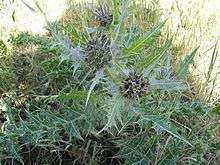Gundelia
| Gundelia | |
|---|---|
 | |
| Gundelia tournefortii | |
| Scientific classification | |
| Kingdom: | Plantae |
| (unranked): | Angiosperms |
| (unranked): | Eudicots |
| (unranked): | Asterids |
| Order: | Asterales |
| Family: | Asteraceae |
| Tribe: | Gundelieae |
| Genus: | Gundelia L. |
| Type species | |
| Gundelia tournefortii[1] L. | |
| Synonyms[2] | |
|
Gundelsheimera Cass. | |
Gundelia is a genus of plants in the sunflower family.[1][3] The best known species is G. tournefortii. It is found in the semi-desert areas of Lebanon, Syria, Palestine, Israel, Jordan, Iraq, Iran, Azerbaijan, Armenia, and Anatolia.
Gundelia tournefortii garnered media attention in 1998 when its pollen grains were found in abundance on the Shroud of Turin. Serving as a claim in establishing its provenance, it has been suggested that this spiny plant was used for the "crown of thorns" worn by Jesus, though others have suggested Christ's thorn jujube (Ziziphus spina-christi).
The leaves, stems, roots, and undeveloped flower buds of G. tournefortii, colloquially known as tumble thistle, are edible when they first sprout in early spring (February–March).[4][5] The plant becomes progressively drier over the summer, it leaves yellowing and growing spikes.[4] Before dying, it detaches from the root to be pushed around by the wind and disperse its seeds for the following year's harvest.[6] Known as aqub (or akub) in Arabic,[4] Arabs use it for food and healing purposes, and respect and identify with the plant. Sold in markets in Jerusalem, Syria, Iraq and Lebanon, it's also gathered in the wild in Turkey. Among Palestinian citizens of Israel in the north of the country, a popular dish using the plant consists of the dethorned heads covered in olive oil and fried, and then simmered with lemon juice.[5]
- Species[2]
- Gundelia aragatsi Vitek, Fayvush, Tamanian & Gemeinholzer - Armenia
- Gundelia tournefortii L. - Lebanon, Syria, Palestine, Israel, Jordan, Iraq, Iran, Azerbaijan, Armenia, and Anatolia
Phylogeny
According to recent genetic analyses, the genus Gundelia is related to the genera Hymenonema, Scolymus and Catananche. This results in the following relationship tree.[7]
| subtribe Scolyminae |
| ||||||||||||||||||
| |
References
- 1 2 Tropicos, Gundelia L.
- 1 2 Flann, C (ed) 2009+ Global Compositae Checklist
- ↑ Linnaeus, Carl von. 1753. Species Plantarum 2: 814. in Latin
- 1 2 3 Tim Vivian (1996). Journeying into God: seven early monastic lives. Fortress Press. p. 80. ISBN 0-8006-2855-1. ISBN 9780800628550.
- 1 2 Wright, Clifford A. (2001). Mediterranean vegetables: a cook's ABC of vegetables and their preparation in Spain, France, Italy, Greece, Turkey, the Middle East, and north Africa with more than 200 authentic recipes for the home cook (Illustrated ed.). Harvard Common Press. pp. 181–182. ISBN 1-55832-196-9. ISBN 9781558321960.
- ↑ Relli de Vries (2011). Hakan Topal, Guven Incirlioglu, eds. The Sea-Image: Visual Manifestations of Port Cities and Global Waters (Illustrated ed.). Newgray. p. 170. ISBN 0-9836031-0-3. ISBN 978-0-9836031-0-8.
- ↑ Liveri, Eleni; Tomasello, Salvatore; Oberprieler, Christoph; Kamari, Georgia (June 2016), Cytological and phylogenetic study of the Greek endemic genus Hymenonema Cass. (Cichorieae, Compositae), retrieved 2016-11-09
Additional reading
| Wikimedia Commons has media related to Gundelia. |
- Karis, P. O., Eldenäs, P. & Källersjö, M. (2001). "New evidence for the systematic position of Gundelia L.". Taxon. 50:: 105–114. ISSN 0040-0262.
External links
- Shroud of Turin reveals images of two crowns of thorns
- Gundelia tournefortii Flowers in Israel